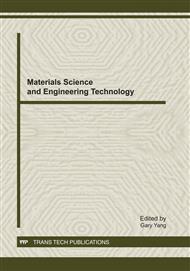[1]
B. Arrivillius, Ark. Kemi 1 (1949), 463; 1(1949), 499.
Google Scholar
[2]
B. Arrivillius, Ark. Kemi 2 (1950), 519.
Google Scholar
[3]
B. Arrivillius, Ark. Kemi 5 (1952), 39.
Google Scholar
[4]
T. Takenaka, J. Ceram. Soc. Japan. , 110(4) (2002), 215.
Google Scholar
[5]
T. Takenaka, and H. Nagata, J. Eur. Ceram. Soc., 25 (12) (2005), 2693.
Google Scholar
[6]
S. Ikegami and I. Ueda Jpn.J. Appl. Phys., 13(10) (1974), 1572.
Google Scholar
[7]
T. Takenaka and K. Sakata, Japan J. Appl. Phys., 19(1) (1980), 31.
Google Scholar
[8]
H. Irie and M. Miyayama, Appl. Phys. Lett., 79(2) (2001), 251.
Google Scholar
[9]
I-S. Yi and M. Miyayamma J. Ceram. Soc. Japan., 106(3) (1998), 285.
Google Scholar
[10]
J.F. Scott, and C.A. Paz de Araujo, Science, 246 (1989), 1400.
Google Scholar
[11]
S.K. Dey, R. Zuleeg, Ferroelectrics, 108 (1990), 37.
Google Scholar
[12]
T. Takeuchi,T. Tani and Y. Saito, Jpn.J. Appl. Phys. 38 (1999), 5553.
Google Scholar
[13]
E.C. Subbarao, Int. Ferroelectr., 12 (1996), 33.
Google Scholar
[14]
R.Z. Hou ,X.M. Chen , J. Mater. Resch., 20 (9)(2005), 2354.
Google Scholar
[15]
Z. Zhang, H. Yan, X. Dong, Y. Wang Mater. Resch. Bull, 38(8) (2003), 241.
Google Scholar
[16]
Chung-Hsin Lu, Chung-Hung Wu, J. Eur. Ceram. Soc., 22 (2002), 707.
Google Scholar
[17]
N. VenkatRamulu, M. Aparna, G. Prasad, G.S. Kumar, and T. BhimaShankaram, Ind.J. pur. Apl. Phys. 39 (2001), 78.
Google Scholar
[18]
N. VenkatRamulu, G. Prasad, S.V. Suryanarayana and T. BhimaShanakaram, Bull. Mater. Sci. 23 (5) (2000), 431.
Google Scholar
[19]
Y.P. Chen, Mater. Lett. 57 (2003), 3623.
Google Scholar
[20]
Sunil Kumar., and Varma, K.B.R., J. Phys. D: Appl. Phys., 42(9)(2009), 075405.
Google Scholar
[21]
Can Jin, Chen-Peng Du, Jun Zhu, Jun-hui He, Xiang-yu Mao and Xiao-bing Chen, J. Phys. D: Appl. phys. 39 (2006), 2415.
DOI: 10.7498/aps.55.3716
Google Scholar
[22]
B. Mamatha A.R. James and P. Sarah, Physica B: Condensed matter 405(2010), 4772.
Google Scholar
[23]
Zhijun Xu, Ruiquing Chu, Jigong Hao, Yanjie Zhang, Guorong Li , Qingrui Yin, Physica B: Condenced matter 404 (2009), (2045).
Google Scholar
[24]
R. Von Hipple, Dielectrics and Waves, john Wiley and sons, NY, (1987).
Google Scholar
[25]
.R. Macdonald, Impedance Spectroscopy, Wiley, NY, (1987).
Google Scholar
[26]
D.C. Sinclair, A.R. West, J. Mater. Sci., 29 (1994), 6061.
Google Scholar
[27]
A.R. James, G.S. Kumar, T. Bhimashankaram, S.V. Suryanarayana, Ferroelectrics 189 (1996), 81.
Google Scholar
[28]
S. Dutta, P.K. Sinha, and R.N.P. choudary, J. Appl. Phys., 96 (2004), 1607.
Google Scholar


